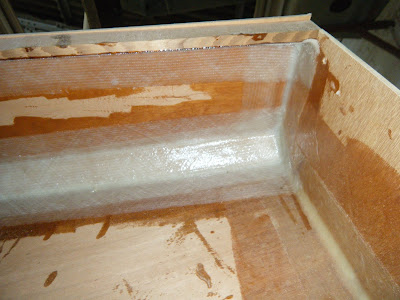Here we go again, been some time! The regular blogger is always busy (me too) so here goes:
Got the boat out of our 'shed' with some difficulty as I forgot to ask our neighbours to leave space for us to get the GT6 out, thank GOD I/we have a handful of friends! To the owners of the cars: sorry if there are any scratches on said vehicles. It took about an hour and a half but eventually got her out and on the trailer.

We used the old set of bunks/poppets that we had the GT6 sat on when we were doing all the work tied to the trailer with some gash line we had.
 Then off to the 'other' boat shed. PJ is making the final poppets for the trailer and helping out with the glassing, filling and fairing of the hull in preparation for painting. There are a number of small jobs to do pre-painting, these hopefully won't take too long. I would like to fit all the hardware, step the mast (bond the mast collar in place, fit the mast step and get the rigging sized) before the painting gets done. It's easy, isn't it? As winter approaches these small tasks get more difficult.
Then off to the 'other' boat shed. PJ is making the final poppets for the trailer and helping out with the glassing, filling and fairing of the hull in preparation for painting. There are a number of small jobs to do pre-painting, these hopefully won't take too long. I would like to fit all the hardware, step the mast (bond the mast collar in place, fit the mast step and get the rigging sized) before the painting gets done. It's easy, isn't it? As winter approaches these small tasks get more difficult.More soon, the hull is glassed and almost finished with the fairing, poppets next










 Cockpit sides on - shown with fillets
Cockpit sides on - shown with fillets 














 More posts and photos when the deck is on completely. Might start to look like a boat then.
More posts and photos when the deck is on completely. Might start to look like a boat then.
 We glassed from the top of the chamfer downwards and then peel-plyed. The plan is to then glass from that join upwards to the underside of the deck when that goes on (which is the next job as I have already cut them) And for the sake of it another layer of glass over the lot as this will be the most likely area of impact. Should that happen!!!!
We glassed from the top of the chamfer downwards and then peel-plyed. The plan is to then glass from that join upwards to the underside of the deck when that goes on (which is the next job as I have already cut them) And for the sake of it another layer of glass over the lot as this will be the most likely area of impact. Should that happen!!!!

